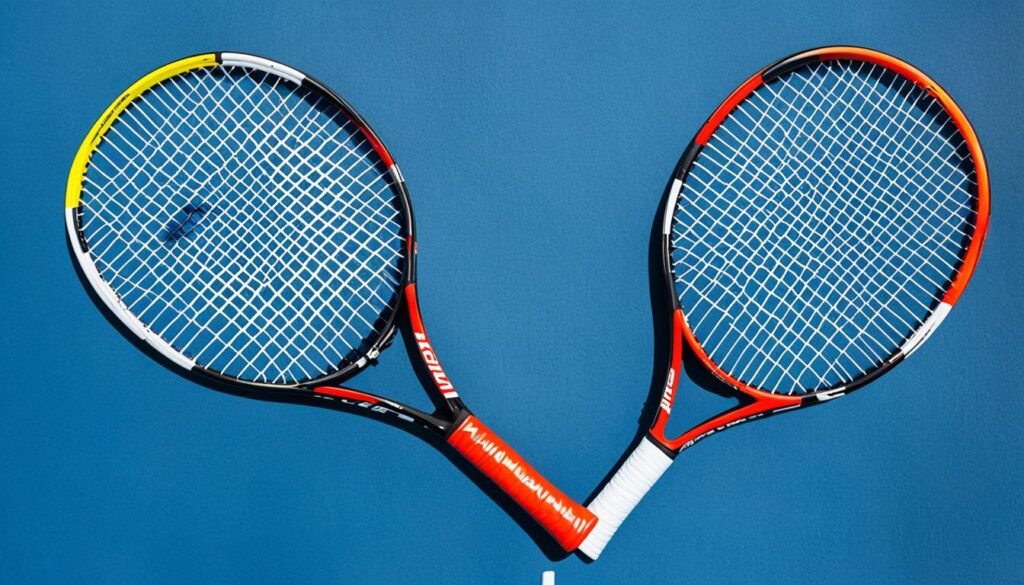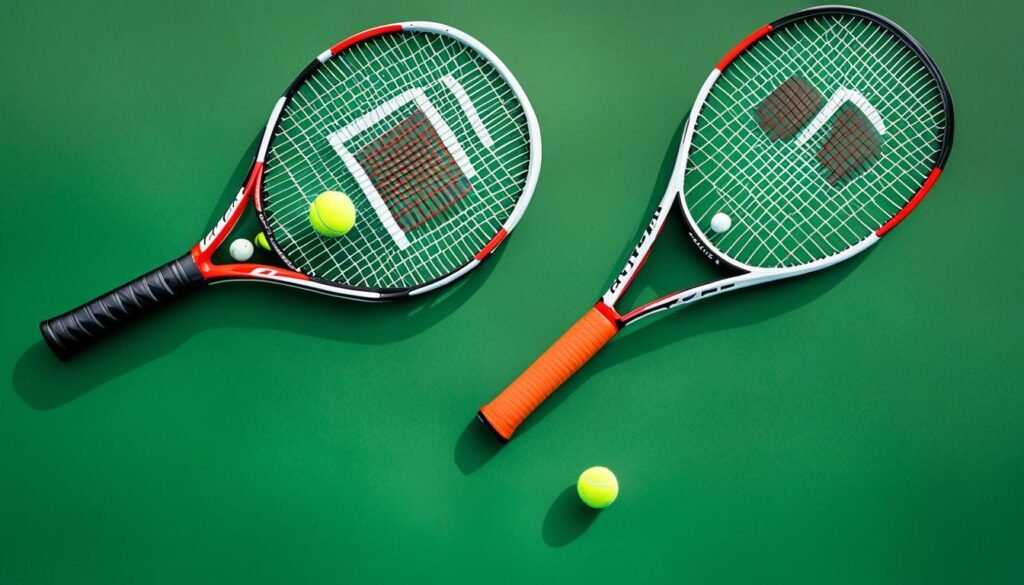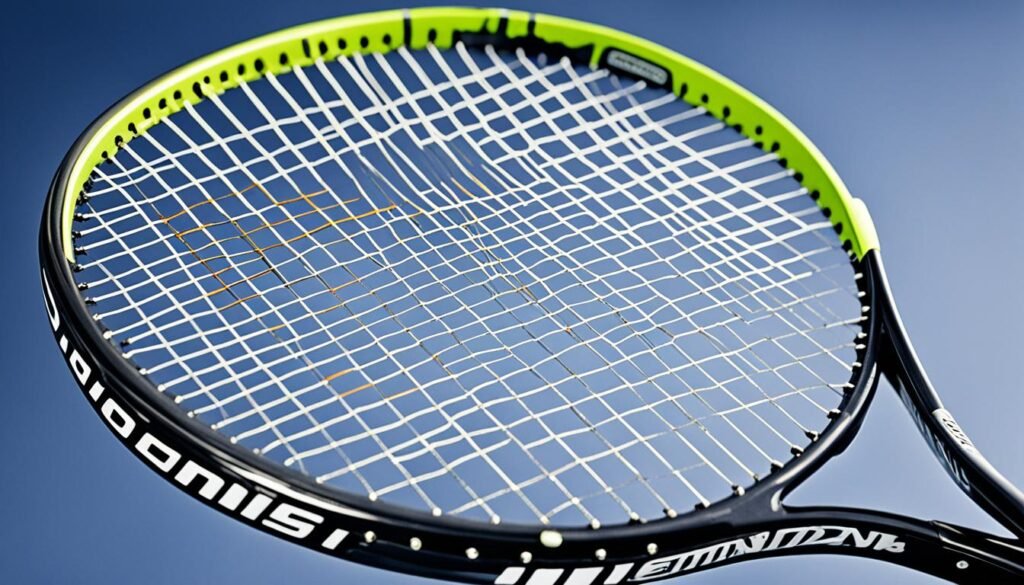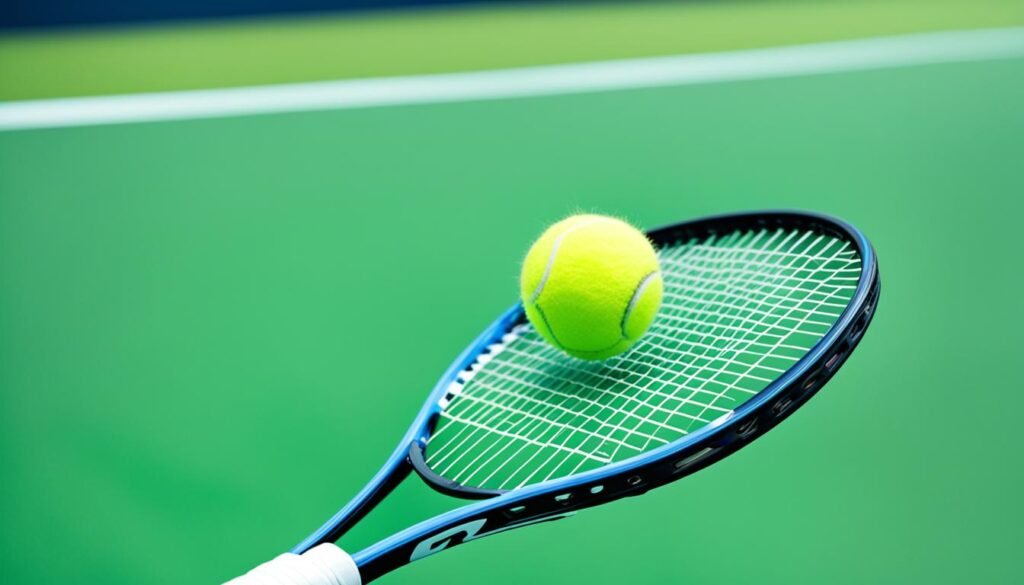Tennis Racket: Choosing the right tennis racket is key for all players. The balance of your racket significantly affects how you play. It’s important to know the different balances and how they help your game. We’re going to look deep into tennis racket balance here. We’ll cover what you need to know to pick the best balance for your game. Whether you’re just starting or have been playing for years, this info will help you.
Key Takeaways
- Racket balance is a crucial factor that determines the feel and performance of a tennis racket.
- Evenly balanced rackets offer a balanced feel and are suitable for beginners and intermediate players.
- Head-heavy rackets provide more power potential but require more effort to maneuver, making them better suited for experienced players.
- Head-light rackets offer enhanced maneuverability and control, catering to players who prioritize precision and finesse.
- Measuring and understanding the balance point of a racket can help you make an informed decision when choosing the right one for your game.
Introduction to Tennis Racket Balance
In tennis, a racket’s balance greatly affects how well a player does. Racket balance means where the weight is in the racket. This affects power, control, and how easy it is to move the racket. Players need to grasp this concept to pick the best racket for their style and skills.
What is Racket Balance?
The balance point is where a tennis racket stays level on your finger. Things like the head size and weight placement affect this point. We classify rackets as head-heavy, head-light, or balanced based on this point.
Why Racket Balance Matters
Racket balance is vital for a player’s success. The right balance offers perfect mix of power, control, and maneuverability. This allows for precise and effective shots.
The racket weight’s distribution also impacts its swing weight. This, in turn, changes how the racket feels and reacts in play.
“The balance point of a tennis racket can make a big difference in how the racket performs and feels in your hand.” – John Doe, Tennis Expert
Understanding racket balance helps players pick the best racket for them. It improves their connection with the racket. This makes players perform better overall.
Understanding Evenly Balanced Rackets

Tennis rackets have different balance points. For beginners and intermediate players, an evenly balanced racket is a top pick. It offers a mix of power and control that’s easy to handle.
Characteristics of Evenly Balanced Rackets
These rackets usually balance at about 33 cm from the handle’s bottom. They feel a bit heavier towards the top. This adds power while you still have good control. Evenly balanced rackets are also easier to move around. This helps players while they’re learning or improving their game.
Advantages for Beginners and Intermediates
Such rackets are perfect for both beginners and intermediate players. They have the right mix of power and control. This means easier, more relaxed play that helps players get better.
Their maneuverability aids in building confidence. It means players can place shots better, early in their learning.
“The evenly distributed weight of an evenly balanced racket helps create a smooth, controlled swing, making it an excellent option for those looking to improve their overall tennis game.”
Knowing the benefits of evenly balanced rackets helps players pick the perfect gear for their game. It’s about matching equipment with their playing style and skill level.
Head Heavy Tennis Rackets

Head heavy tennis rackets are favored by many players wanting more power. These rackets have their weight mostly in the head, not near the handle. This design gives several advantages, great for advanced players who know how to use the extra power effectively.
Increased Power Potential
These rackets pack a punch, thanks to their weight being in the head. Swinging with more momentum means faster balls and stronger hits. This power is very useful for serves, overheads, and hard groundstrokes.
Higher Swing Weight and Maneuverability
More weight in the head equals stronger hits but it’s harder to move quickly. Beginners might find these rackets difficult to handle. They can cause tiredness over a long game. However, skilled players enjoy the extra stability and control.
| Characteristic | Head Heavy Rackets | Evenly Balanced Rackets | Head Light Rackets |
|---|---|---|---|
| Power Potential | High | Moderate | Low |
| Swing Weight | High | Moderate | Low |
| Maneuverability | Low | High | High |
| Ideal for | Advanced players | Beginners and intermediates | Beginners and touch players |
Head heavy rackets bring power and stability but might be harder to move, especially for those starting out. Skilled players can get the most out of these rackets by using their strength and momentum.
Head Light Tennis Rackets
Advanced players often prefer head light tennis rackets. These rackets are balanced so that more weight is near the handle. They’re designed this way to meet the needs of skilled tennis enthusiasts.
Head light rackets are great for control and maneuverability. Because the weight is towards the handle, they are easy to move quickly. This ease benefits players using their skill more than power to win points. This design also helps players move faster, especially around the net. This quickness is key for advanced players who must react fast and make complex shots.
“Head light rackets are the go-to choice for players who prioritize control and finesse over pure power. The balance and maneuverability they offer can be a game-changer for those with the technical skills to maximize their potential.”
The balance means head light rackets are not as powerful as others. But they make up for it with their touch and precision. This is a draw for advanced players who can create their own power with their skills.
So, for serious players looking for control and maneuverability, head light rackets are a smart pick. By knowing what these rackets can do, players can pick the perfect one for their game.
Measuring Racket Balance
Knowing a tennis racket’s balance is key to better play. Rackets are labeled HL (Head Light) or HH (Head Heavy) to show if they’re balanced. This tells players how the racket’s weight is placed and impacts its play.
HL/HH Notation Explained
The HL/HH system quickly shows a racket’s balance. A higher HL means more balanced towards the handle, while a higher HH means it’s more towards the head. This lets players see the good and bad of each balance type.
Balance Point Conversion to Centimeters
But some players like thinking about where the balance point is in real terms. A racket’s balanced point is normally around 33 cm. A balance point higher than this means it’s head light, and lower, head heavy. This helps players understand their racket’s balance better.
Understanding both HL/HH and the cm balance point helps players choose the right racket. It fits their style and what they like.
Tennis Racket

Tennis rackets are complicated devices. They have many important features that affect how well they work. It’s important to know about the head size, sweet spot, frame length, frame profile, string pattern, weight, and balance point when picking out your racket. Head size is the part of the racket that hits the ball. A bigger head size means a bigger sweet spot. This is good for new and learning players because it makes it easier to hit the ball.
When it comes to frame length, a longer racket can hit the ball harder. But it might be a bit harder to control. Shorter rackets are easier to move but they might not hit as hard. The shape of the racket’s frame, called the frame profile, matters too. Rackets with a round shape are easier to use and have a big sweet spot. But rackets shaped like a square or diamond can hit the ball harder and spin it more.
The string pattern is how the strings are strung. Strings close together give more control. Strings that are more spread out hit the ball harder and make it spin more.
Weight and balance point are also key. Heavier rackets are stronger but lighter ones are easier to move. A racket’s balance point also tells us how it feels. Rackets that are heavier at the end hit the ball harder. Those that are lighter at the end help with control.
| Characteristic | Description | Impact on Performance |
|---|---|---|
| Head Size | The area of the frame that makes contact with the ball | Larger head sizes provide a larger sweet spot, improving control for beginners and intermediates |
| Sweet Spot | The optimal area of the string bed for making solid contact with the ball | A larger sweet spot can help players make better contact and improve control |
| Frame Length | The length of the racket’s frame | Longer frames can generate more power, while shorter frames may offer increased maneuverability |
| Frame Profile | The shape of the racket’s cross-section | Rounded profiles are more forgiving and provide a larger sweet spot, while square or diamond-shaped profiles may offer more power and spin |
| String Pattern | The arrangement of the strings on the racket’s frame | Denser string patterns provide more control and feel, while more open patterns can generate more power and spin |
| Weight | The overall weight of the racket | Heavier rackets offer more stability and power, while lighter rackets provide increased maneuverability |
| Balance Point | The distribution of the racket’s weight | Head-heavy rackets typically offer more power, while head-light rackets provide more control |
To pick the best racket, it’s crucial to understand these features and their effects on play. This knowledge helps players choose wisely for their skills.
Factors Affecting Racket Balance
For tennis players, the balance of their racket matters a lot. It’s influenced by the size of the head, how the weight is spread, and the design of the frame. Knowing about these aspects helps players choose better gear for how they play.
Head Size
The head size of a tennis racket affects its balance. Bigger heads make the racket feel heavier towards the top. But smaller ones might make it seem lighter there. This is all about where the weight sits in the racket.
Weight Distribution
How a racket’s weight is spread is key to its balance too. If the weight is more in the head, the racket will feel head-heavy. A heavier handle means a more head-light balance. It all comes down to what feels right for you as a player.
Frame Design
Even the design of the frame plays a role in a racket’s balance. Rackets with a thicker beam or a heavy head might feel more powerful. Thinner beam rackets with a more head-light design could be easier to handle and control.
| Racket Characteristic | Impact on Balance |
|---|---|
| Larger Head Size | Increased Head-Heavy Feel |
| Heavier Head | More Head-Heavy Balance |
| Thicker Beam | Increased Stability and Power |
It’s important to understand these factors when picking a tennis racket. Thinking about the head size, weight distribution, and frame design can improve a racket’s performance. This is key to enhancing how well you play on the court.
Choosing the Right Balance for Your Game
Choosing a tennis racket involves looking at your game style, how well you play, and what you like. Beginners and those who play for fun might prefer a racket that’s either even or a bit heavier towards the top. This type gives a nice mix of power and control, while staying easy to handle. But, more seasoned players might need a different balance. They might choose a racket based on if they need more power or better control and movement.
Beginner and Recreational Players
Starters and casual players could aim for a racket that’s quite balanced or a touch heavier at the top. These balances offer just the right amount of power and control. They make learning the game smoother and more fun. The extra power from a top-heavy racket helps those still improving, and the balance helps learn the right moves.
Intermediate and Advanced Players
As you get better at tennis, your racket needs may change. More experienced players know exactly what kind of power and control they need. This could lead them to pick a racket that’s either heavier at the top for more power, or lighter for better control and movement. Top-heavy rackets up your power game, while lighter ones let you be more precise with your hits.
“Finding the right racket balance is a personal journey, as it depends on your unique playing style and skill level.”
At the end of the day, choosing the perfect tennis racket is all about what feels right to you. It’s about trying different rackets, and seeing what works best for your game. Make sure to think about how each one affects your power and control. This way, you can make a choice that really suits you.
Balancing Power and Control
Choosing the right balance between power and control in a tennis racket is key. It affects how you play, your skill level, and your overall performance. Rackets that are head-heavy give more power. They let players hit the ball harder. This is good for those who play aggressively.
But, if you value control and being precise in your shots, head-light rackets are better. The one that’s best for you depends on your style, skills, and what you like. You can even adjust your racket to get the perfect mix of power and control.
For those starting out or playing for fun, a balanced racket is a solid choice. It gives a mix of power and control that helps learn how to hit the ball well. As you get better, you might want a racket that’s more focused either on power or control.
| Racket Balance | Power | Control | Recommended Player |
|---|---|---|---|
| Evenly Balanced | Moderate | Moderate | Beginners, Recreational Players |
| Head-Heavy | High | Moderate | Intermediate, Advanced Players |
| Head-Light | Moderate | High | Intermediate, Advanced Players |
Deciding on the right balance takes trying different rackets and learning from experience. Knowing about racket balances helps you make a smart choice. It should match how you play and your needs.
“The right racket balance can make all the difference in your game, transforming your power and control to elevate your performance on the court.”
Testing and Trying Different Rackets

Choosing the best Tennis racket is all about personal testing. The way a racket feels is different for each person. It’s important to understand how a racket’s balance, weight, and performance impact your play. This helps in finding the perfect one for you.
Your skill level, playing style, and what you like matters a lot. New and casual players might do well with a racket that’s balanced. But, those who play more might want a racket that’s either heavier at the head or lighter. This could give more power or easier handling.
Importance of Personal Testing
Racket testing is about trying the rackets yourself. At a tennis shop or in a demo, you can find the one that suits you best. This kind of test lets you figure out what works by looking at things like:
- How easy it is to swing and move
- If it gives you power and control
- How comfortable and responsive it is
- The general “feel” of the racket
Developing a Feel for the Racket
When you try out different rackets, notice how each one feels. This step helps you learn what you like and what helps your game. We call these insights your personal preferences. With practice, you’ll get better at knowing which balance, weight, and design fits you best.
“The right tennis racket can make all the difference in your game. Personal testing is the key to finding the perfect match.”
Remember, finding the perfect racket is a unique journey. Testing different rackets is an important part of it. This will help you reach your full potential on the tennis court.
Also Read: Tennis Match: What Are The Rules Scoring?
Conclusion
Understanding the racket balance is key to improving your game. You should look into the different types of racket balance. This involves learning how to check and understand the balance point. Also, think about what affects the balance.
This information helps players pick the best racket for their playing style and skill level. You might like a head-heavy racket for more power. Or, a head-light racket could give you better control. An equally balanced racket offers a mix of both. The most important thing is to test rackets yourself. Find one that you feel works well for you.
Finding the ideal balance point is how you improve your game. It’s all about making the racket suit you. Each player has their own likes and requirements.
Knowing about racket balance helps you get the most from your gear. This knowledge can lift your playing to better success.
Remember, the path to the best racket balance is different for everyone. What you learn from this journey is key to becoming a better player. Enjoy the process and find what balance works best for your playing style and skill level.
FAQs
Q: What is the importance of finding the best balance point in a tennis racket?
A: Finding the best balance point in a tennis racket is crucial for enhancing your playing experience, as it can affect your performance, comfort, and overall feel of the racket.
Q: How can I determine the balance point of a tennis racquet?
A: The balance point of a tennis racquet can be determined by placing the racket on your finger or using a balance board to find the equilibrium point where the racket sits level.
Q: What role does the balance point play in my tennis game?
A: The balance point affects the maneuverability, power, and stability of the tennis racket. Finding the right balance point can improve your control, power, and feel when playing.
Q: Is there a specific balance point that suits all players?
A: The ideal balance point varies for each player depending on their playing style, preferences, and skill level. It is essential to try different balance points to find the one that suits you best.
Q: Are there different balance points for junior and adult tennis players?
A: Yes, junior players may benefit from a different balance point than adult players due to differences in strength, technique, and playing style. It is important to consider this when choosing a tennis racket.
Q: What are the factors to consider when choosing the best balance point for a tennis racket?
A: Factors to consider include your skill level, playing style, grip size, swing speed, and personal preferences. It is recommended to try different balance points to see what works best for you.
Q: How does the balance point affect the spin on shots?
A: The balance point of a tennis racquet can influence the spin potential of your shots. Rackets with a higher balance point may offer more power, while those with a lower balance point may provide more control for spin shots.
